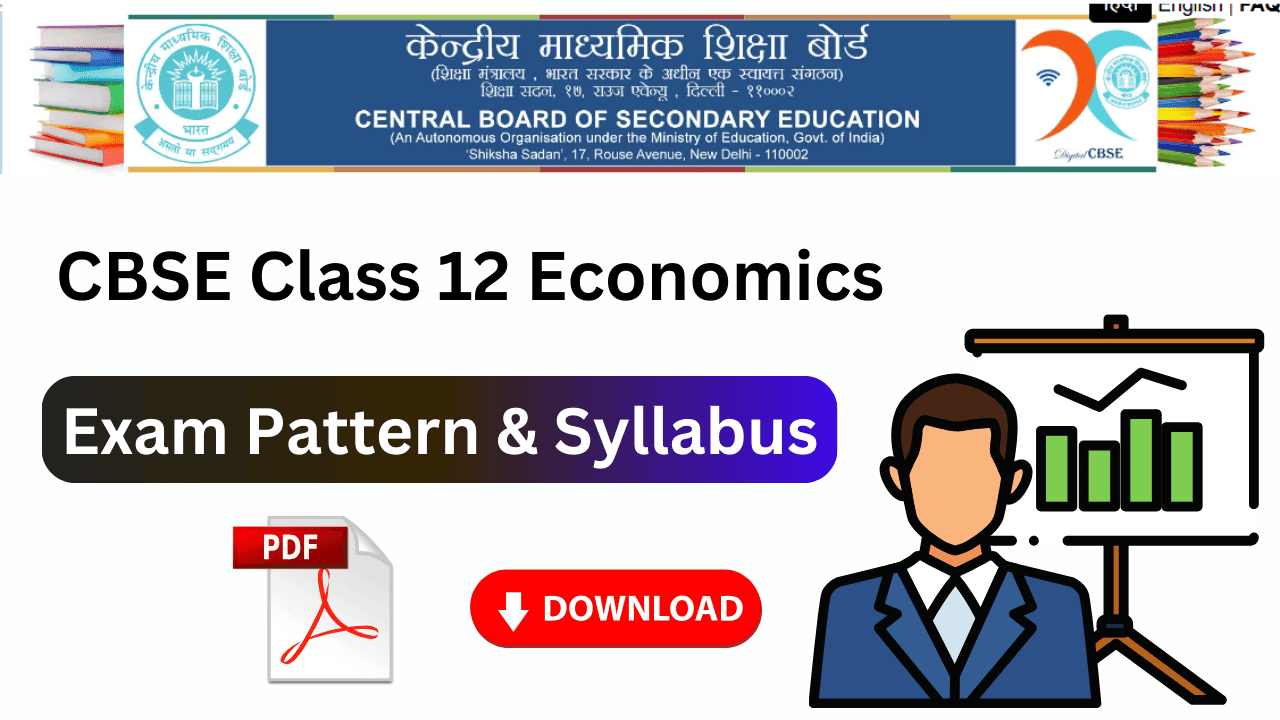Updated CBSE Class 12 Economics Syllabus for 2025-26 – Get the latest chapter-wise syllabus, marking scheme, and study tips. Download the official PDF at the end!
Overview of CBSE Class 12 Economics Syllabus 2025-26
The Class 12 CBSE syllabus for Economics plays a crucial role in board exams and competitive exams like CUET. This year, CBSE has introduced competency-based questions and a revised weightage system to encourage conceptual learning over rote memorization.
| Board | CBSE |
| Class | 12 |
| Session | 2025-26 |
| Subject | Economics |
| Content-Type | Syllabus/Curriculum |
| Official Website | https://cbseacademic.nic.in |
ECONOMICS (Subject Code 030) - CLASS XII (2025-26)
Examination Structure:
- Theory: 80 marks (3 hours)
- Project Work: 20 marks
- Total: 100 marks
Part A: Introductory Macroeconomics (40 marks)
| Unit | Topic | Marks |
|---|---|---|
| 1 | National Income and Related Aggregates | 10 |
| 2 | Money and Banking | 6 |
| 3 | Determination of Income and Employment | 12 |
| 4 | Government Budget and the Economy | 6 |
| 5 | Balance of Payments | 6 |
| Total Part A | 40 |
Part B: Indian Economic Development (40 marks)
| Unit | Topic | Marks |
|---|---|---|
| 6 | Development Experience (1947-90) and Economic Reforms since 1991 | 12 |
| 7 | Current Challenges facing Indian Economy | 20 |
| 8 | Development Experience of India - A Comparison with Neighbours | 8 |
| Total Part B | 40 |
Part C: Project Work (20 marks)
Part A: Introductory Macroeconomics (40 Marks)
Unit 1: National Income & Related Aggregates (10 Marks)
Key Concepts:
- Macroeconomics: Meaning & scope
- Basic Concepts:
- Consumption goods, capital goods, final & intermediate goods
- Stocks vs flows
- Gross investment & depreciation
Circular Flow of Income:
- Two-sector model
National Income Calculation Methods:
- Value Added/Product Method
- Expenditure Method
- Income Method
Aggregates:
- GDP, GNP, NDP, NNP (at market price & factor cost)
- Real vs Nominal GDP
- GDP Deflator & GDP as welfare indicator
Unit 2: Money & Banking (6 Marks)
Money:
- Meaning & functions (medium of exchange, store of value, etc.)
- Money Supply:
- Currency held by public + Net demand deposits
Commercial Banks:
- Money creation process (credit multiplier)
Central Bank (RBI):
- Functions:
- Bank of issue
- Government’s banker
- Banker’s bank
- Credit Control Tools:
- CRR, SLR, Repo/Reverse Repo Rate
- Open Market Operations
- Margin requirements
Unit 3: Income & Employment (12 Marks)
Aggregate Demand (AD):
- Components: Consumption, Investment, Govt. spending, Net exports
Propensity to Consume/Save:
- Average & marginal propensity
Equilibrium Output:
- Short-run equilibrium
- Investment Multiplier: Concept & working
Employment Concepts:
- Full employment vs involuntary unemployment
Demand Issues:
- Excess/Deficient Demand: Causes & corrective measures
- Fiscal policy (govt. spending/tax changes)
- Monetary policy (money supply adjustments)
Unit 4: Government Budget (6 Marks)
Budget:
- Meaning, objectives (growth, equity, stability)
Components:
- Receipts: Revenue (tax/non-tax) vs Capital
- Expenditure: Revenue vs Capital
Budget Types:
- Balanced, Surplus, Deficit
- Deficit Measures:
- Fiscal deficit, Revenue deficit, Primary deficit
Unit 5: Balance of Payments (6 Marks)
BoP Account:
- Components: Current account, Capital account
- Surplus vs Deficit
Foreign Exchange Rate:
- Systems: Fixed, Flexible, Managed Floating
- Determination: Free market dynamics
- Merits/Demerits of exchange rate systems
Part B: Indian Economic Development (40 Marks)
Unit 6: Development Experience (1947-90) & Reforms (12 Marks)
Pre-Reform Era:
- State of Indian economy at independence
- Five Year Plans: Goals & achievements
- Sectoral challenges & policies:
- Agriculture: Land reforms, Green Revolution
- Industry: IPR 1956, Small-scale industries (SSI)
- Foreign Trade: Import substitution
Post-1991 Reforms:
- LPG Policies:
- Liberalization, Privatization, Globalization
- Appraisal of reforms
- Key initiatives:
- Demonetization
- GST (Goods & Services Tax)
Unit 7: Current Challenges (20 Marks)
1. Human Capital Formation:
- Role in economic development
- Education sector growth
2. Rural Development:
- Credit & marketing (Cooperatives)
- Agricultural diversification
- Organic farming
3. Employment:
- Workforce trends (formal vs informal sectors)
- Policies for job creation
4. Sustainable Development:
- Environment vs growth trade-offs
- Global warming concerns
Unit 8: Comparative Development (8 Marks)
India vs Neighbors:
- Pakistan & China:
- Economic growth rates
- Population dynamics
- Sectoral contributions (agriculture/industry/services)
- HDI Indicators: Health, education, income
Part C: Project Work (20 Marks)
Guidelines:
- Apply theoretical concepts to real-world economic issues
- Suggested formats:
- Case studies
- Surveys & data analysis
- Policy evaluations
Prescribed Books:
- NCERT Textbooks:
- Indian Economic Development
- Macroeconomics
- CBSE Supplementary Material
Question Paper Design | March 2026 Examination
| Total Marks: 80 | Duration: 3 Hours |
|---|
Assessment Framework
| S.No. | Cognitive Skill | Marks | Weightage | Question Types |
|---|---|---|---|---|
| 1 | Remembering & Understanding | 32 | 40% | Definitions, concepts, comparisons, explanations |
| 2 | Applying | 24 | 30% | Numerical problems, diagram-based questions, policy applications |
| 3 | Analyzing, Evaluating & Creating | 24 | 30% | Case studies, data interpretation, critical essays |
| Total | 80 | 100% |
Download CBSE Class 12 Economics Syllabus 2025-26 PDF
Click the button below to download the official CBSE syllabus PDF for 2025-26.
📂 Download CBSE Class 12 Economics Syllabus PDF
Related Guides
CBSE Class 12 Syllabus – All Subjects
Class 12 Economics Important Questions & Answers
Stay Updated!
Join our Telegram/WhatsApp group for CBSE updates, free notes, and exam tips!
Bookmark this page & keep revising smartly!
